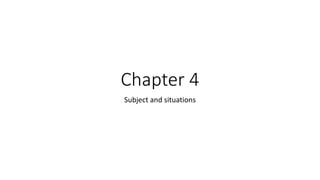
chapter 4 Subject and Situation
- 1. Chapter 4 Subject and situations
- 2. Obviousness • The French philosopher Louis Althusser pointed an important connection between common-sense (obviousness) assumptions about meaning , and common-sense assumptions about social identity or the 'subject‘. • obviousness, including “naming a thing" or 'have a meaning" is all about transparency" of language. • the obviousness is an ideological effect, the elementary ideological effect: and Althusser adds that 'linguists and those who appeal to linguistics for various purposes often run up against difficulties which arise because they ignore the action of the ideological effects in all discourses - including even scientific discourses'.
- 3. Transparency of language • Transparency of language is a general property which is illustrated for instance about meaning. • the social processes constituting languages in general (and meanings in particular) are hidden beneath their appearance of being just naturally, commonsensically 'there'.
- 4. Subject position in a discourse • the ideological effect of one's 'subjecthood' being perceived as commonsensically given, rather than socially produced, is an effect that comes about pre-eminently in language and in meaning. • the socialization of people involves them coming to be placed in a range of subject positions, which they are exposed to partIy through learning to operate within various discourse types. • Each discourse type establishes its particular set of subject positions, which those who operate within it are constrained to occupy.
- 5. Subject position • Subject positions are specific to discourse types, and ideologically variable. • Notice the power which is at stake in the struggle between discourses in this respect: it is the power to create the image, so to speak, of the ideological ideal. • People sometimes feel the lack of an ideologically neutral term for referring to a person in receipt of medical care - for instance, when the term patient is used to refer to a woman in childbirth, inevitably portraying her as helpless, sick, and having things done to her rather than doing things (like giving birth!) herself.
- 6. Range of Subject Positioning • The social process of producing social subjects can be conceived of in terms of the positioning of people progressively over a period of years - indeed a lifetime - in a range of subject positions. • The social subject is thus constituted as a particular configuration of subject positions. A consequence is that the subject is far less coherent and unitary than one tends to assume.
- 7. Subjects as composite personalities • social subjects are, in Gramsci's words, 'composite personalities'. • In Foucault’s terms: the subject is dispersed' among the various subject positions • There is a thinking, knowing, speaking subject, • but, on the contrary, there is a totality, in which the dispersion of the subject and his discontinuity with himself may be detemrined. • This has profound implications for our tendency to see a speaker or writer as the author of her words: there is a sense, on the contrary, in which the speaker or writer is a product of her words. However, there is a dialectical process in discourse wherein the subject is both created and creative.
- 8. Situations of Discourse • We take the situations in which discourse is accepted as 'obviousnesses' causing no problems. • Situations may exist prior to and independently of discourse as we tend to commonsensically assume They are in a sense the products of discourse, particular discourse types and orders of discourse having their own particular inventories of the situation types, and there being consequently different ideologically contrastive inventories.
- 9. Achievement of Naturalization • Both the subject positions and the situation types of dominant discourse types are (like the meanings of their words, and the properties of their interactional routines) liable to be naturalized. • The naturalization of the meanings of words is an effective way of constraining the contents of discourse and, in the long term, knowledge and beliefs. So too is the naturalization of situation types, which helps to consolidate particular images of the social order. • The naturalization of interactional routines is an effective way of constraining the social relations which are enacted in discourse, and of constraining in the longer term a society's system of social relationships. • Finally, the naturalization of subject positions self-evidently constrains subjects, and in the longer term both contributes to the socialization of persons and to the delimitation of the 'stock' of social identities in a given institution or society. Naturalization, then, is the most formidable. weapon in the armory of power, and therefore a significant focus of struggle.
- 10. 'Making trouble': Foregrounding Common Sense This chapter highlights the backgrounded and unconscious nature of ideological common sense, that explained how common sense can be foregrounded. • Interactional routines and their boundaries is a situation in which the common-sense elements of discourse are brought out into the open is when things go wrong in discourse. • CLS can correspondingly focus upon instances of communication breakdown and miscommunication, and instances where people attempt to 'repair' their discourse, as a way of highlighting and foregrounding discoursal common sense.
- 11. Foregrounding Common Sense • Another situation where common-sense elements are 'spontaneously‘ foregrounded is: where there is a sufficiently large social or cultural divide between participants in an exchange, or between participants in and observers of an exchange, for the arbitrariness and social relativity of the common sense of one to be evident to others. • A third possibility is the deliberate disturbance of common sense through some form of intervention in discourse.
- 12. Conclusion • The chapter hence targets on construal of common sense. • It describes the world of everyday life with ideologies embedded in discourse as a matter of common sense. • Fairclough declares that when an ideology becomes common sense it becomes a power in disguise that enables a social being to challenge and foreground other ideologies.